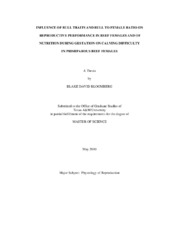| dc.description.abstract | The current study involved two experiments that were conducted at the Texas A&M AgriLife Research and Extension Center in Uvalde, TX (semi-arid environment) from 2006 to 2008. In experiment one, Bonsmara bulls ( n = 39; 20-24 mo of age) were joined with multiparous Bonsmara and Bonsmara-influenced females (n = 1013) during a 90-day breeding season in 2006, 2007, and 2008 to quantify the effects of a reduction in bull to female ratio on reproductive performance. Bulls were also placed with primiparous beef females ( n = 142). Bulls were allotted by selected physical traits, social rank, serving capacity, and seminal traits to one of two bull to female (BFR) treatments: Low (1:30-1:45; n = 10 pastures) or Conventional (1:16-1:26; n = 12 pastures) BFR. Pregnancy rate (P = 0.36), calving date (P = 0.24), and calving rate (P = 0.25) did not differ between Conventional and Low BFR treatments. The current experiment demonstrates that Low BFR can be utilized in breeding pastures of up to 2,090 ha without negatively affecting reproductive performance. In experiment two, Bonsmara heifers (3/4, 7/8, and full bloods) were exposed to Bonsmara bulls from April 15 to July 15 during each of the two years. Heifers were weighed, rectally palpated for pregnancy, and scored for BCS (1 thin - 9 fat) and frame score (1 short - 9 tall) in December (end of second trimester) during years 1 and 2. Heifers were stratified on expected calving date and randomly allotted to one of two levels of nutrition for the remainder of gestation. In year 1, heifers were allotted to range forage (n=31, low nutrition, LN) or to non-irrigated oat pasture (n=31, high nutrition, HN). In year 2, heifers were placed onto the same range environment as in year 1 (n=31, LN) or onto irrigated ryegrass pasture (n=31,HN). Heifers in the LN groups were supplemented with 20% CP cubes at the rate of 0.9 kg/heifer/day from January 2 until calving while HN heifers were not supplemented. Within 4 hr of birth, calves were weighed, and calf vigor and calving difficulty scores were recorded. Heifers were weighed within 72 hours of parturition. From treatment initiation through calving, HN heifers gained 48.6 kg whereas the LN females lost 15 kg. Twice as many HN heifers required major assistance at calving as compared to LN heifers. Calves born to the HN females weighed 3.7 kg more at birth than those born to LN females. These differences resulted in HN heifers having (P = 0.005) more calving difficulty than LN heifers (mean calving difficutly of 2.3 for HN and 1.6 for LN). The calves of the HN females were also less vigorous (P = 0.005) after birth than the calves from LN females (calf vigor score of 2.2 for HN and 3.3 for LN). Consequently, the level of nutrition during the third trimester of gestation can affect calving difficulty, calf vigor, and female weight. | en |


